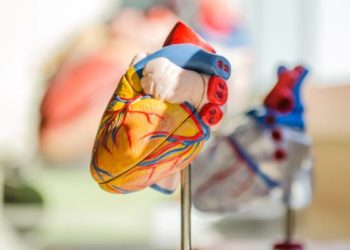Social and genetic risk scoring may improve coronary heart disease risk prediction
1. In this prospective study, polysocial and polygenic risk scores were independently associated with incident coronary heart disease.
2. Further, incorporation of polysocial and polygenic risk scores for coronary heart disease into pre-existing clinical risk calculators improved their performance.
Evidence Rating Level: 2 (Good)
Study Rundown: Coronary heart disease (CHD), like many other conditions, results from the interplay of numerous genetic and environmental factors. Polygenic risk scores (PRSs) quantify genetic susceptibility whereas polysocial scores (PSSs) account for the effects of various environmental factors on health outcomes, including social determinants of health (SDOH) and lifestyle-psychologic factors. Prior studies have demonstrated inconsistent evidence for the incorporation of SDOH on disease prediction models due to discrepancies in the combinations of SDOH considered and measured health outcomes. While lifestyle-psychologic factors such as impaired sleep and low levels of physical activity have been associated with increased risk of CHD, risk prediction models used around the world have yet to fully incorporate PRSs and PSSs. This hesitancy is thought to be primarily due to uncertainty regarding whether joint modeling would improve the prediction of incident CHD, and what type of modifying effect PRSs and PSSs may have. Hence, this prospective cohort study was designed to investigate the strength of the association between PSSs and incident CHD, and subsequently develop and validate a clinical risk calculator for CHD which incorporates both PSSs and PRSs. Overall, PSSs and PRSs were found to be independently associated with CHD, and their effects appeared to be additive. Additionally, joint modeling of these variables significantly improved the performance of existing clinical risk calculators for CHD. The generalizability of the study was limited by a predominantly White cohort and the calculation of PSS at only one point in time. Nonetheless, these results suggested that integration of genetic, social, and lifestyle factors may dramatically improve the accuracy of CHD risk calculation.
Click to read the study in AIM
Relevant Reading: Association of joint genetic and social environmental risks with incident myocardial infarction: results from the health and retirement study
In-Depth [prospective cohort]: This prospective cohort study aimed to ascertain the association between PSSs and incident CHD, as well as develop and validate a clinical risk prediction model for CHD which included joint modelling of PSSs and PRSs. Participants between the ages of 40 and 70 years from the UK Biobank were recruited between 2006 and 2010, and data regarding their demographic, genetic, SDOH, and lifestyle-psychologic factors were obtained. Incident CHD was defined as a composite of fatal and non-fatal myocardial infarction, coronary revascularization, or both within 10 years of recruitment. PRS for CHD (PRSCHD) was calculated using a meta genomic risk score, and PSS for CHD (PSSCHD) was developed using 9 distinct domains, including adulthood relationship, education, entertainment, housing, income, occupation, physical activity, sleep, and psychological health. The study cohort included 388,224 participants with a mean age of 55.5 years, of which 42.5% were male and 94.9% were of self-reported White ethnicity. Overall, 9,784 participants (2.5%) had at least 1 incident event of CHD. The hazard ratio for 1 standard deviation (SD) increase in PSSCHD for incident CHD and 1 SD increase in PRSCHD for incident CHD was 1.43 (95% confidence interval [CI], 1.38 to 1.49; P<0.001) and 1.59 (95% CI, 1.53 to 1.66; P<0.001), respectively. In terms of PSSCHD, physical activity, sleep, education, and psychological health exhibited the highest importance in CHD risk prediction. Because PSSCHD and PRSCHD were normally distributed, incorporation of these variables into comprehensive risk scores (CRSs) did not affect the calibration of the clinical risk calculators: CRSPCE, CRSPREVENT, and CRSQRISK3. At a 10-year CHD risk threshold of 7.5%, CRSPCE reclassified 12% of participants, with the up-reclassified participants exhibiting a 1.86-times higher CHD risk (95% CI, 1.32 to 2.62; P<0.001) than those who were down-reclassified. Similar results were seen for CRSPREVENT and CRSQRISK3, as well as for the 10-year CHD risk threshold of 10.0%. In summary, this study demonstrated that PSSCHD was associated with incident CHD and joint modeling of PSSCHD and PRSCHD appeared to improve the performance of CHD risk prediction.
Image: PD
©2024 2 Minute Medicine, Inc. All rights reserved. No works may be reproduced without expressed written consent from 2 Minute Medicine, Inc. Inquire about licensing here. No article should be construed as medical advice and is not intended as such by the authors or by 2 Minute Medicine, Inc.









